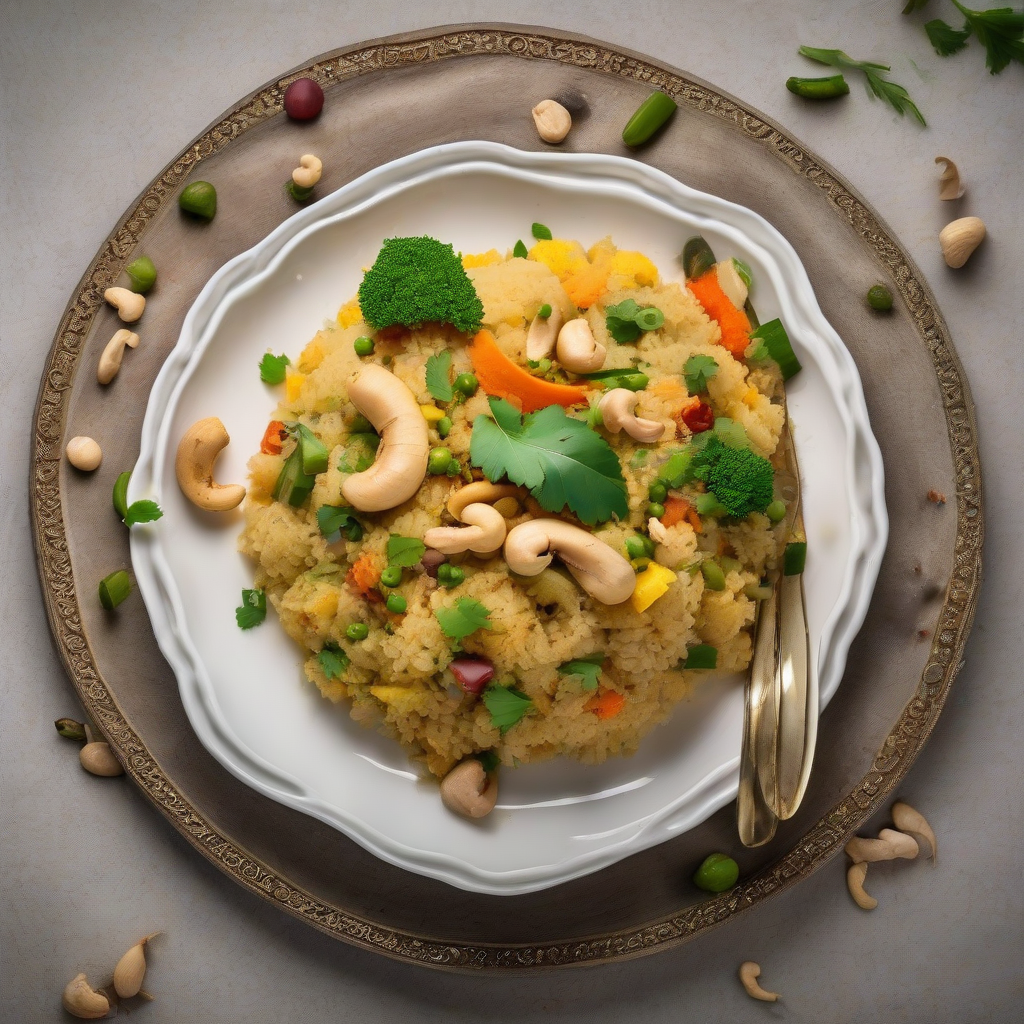Upma: A South Indian Delight to Spice Up Your Day, Yaar!
Namaste Dosto! Kem cho? Vanakkam! Sat Sri Akal! Chef Curry Do’pyaza here, back in your kitchens and ready to bring a burst of flavor to your day!
Today, we are diving headfirst into a dish that’s close to my heart, a true South Indian staple: Upma with Vegetables and Cashews. This isn’t just breakfast; it’s a warm hug in a bowl, a comforting friend on a chilly morning, and a delightful way to sneak in some veggies for the little ones (and maybe even the big ones!).
Upma is a popular dish in South Indian homes. You’ll find it gracing tables during festivals like Pongal, Ugadi, and Diwali. It’s also a common breakfast item, a quick lunch option, or even a light dinner. It’s a versatile dish, perfect for any time of year and any occasion.
A Little History Lesson, My Friends
Upma, in its simplest form, has been around for centuries in South India. It’s believed to have originated as a way to use leftover rice or broken wheat. Over time, it evolved into the delicious, savory dish we know and love today. The addition of vegetables and cashews is a more modern twist, adding extra nutrients and a satisfying crunch.
Let’s Get Cooking!
- Preparation Time: 10 minutes
- Cooking Time: 20 minutes
Ingredients You’ll Need:
- 1 cup Sooji/Rava (Semolina)
- 2 tablespoons Tel (Vegetable Oil)
- 1 teaspoon Rai (Mustard Seeds)
- 1 teaspoon Urad Dal (Split Black Gram)
- 1 teaspoon Chana Dal (Split Chickpea Lentils)
- 1/4 cup Pyaaz (Onion), finely chopped
- 1 Hari Mirch (Green Chili), finely chopped (adjust to your spice level)
- 1/2 inch Adrak (Ginger), grated
- 1/4 cup Gajar (Carrot), finely chopped
- 1/4 cup Matar (Green Peas)
- 1/4 cup Shimla Mirch (Capsicum/Bell Pepper), finely chopped
- 1/4 cup Kaju (Cashews)
- 2 cups Pani (Water)
- 1 teaspoon Namak (Salt), or to taste
- 1/2 teaspoon Haldi (Turmeric Powder)
- 2 tablespoons Hara Dhaniya (Fresh Coriander Leaves), chopped for garnish
- 1 tablespoon Nimbu ka Ras (Lemon Juice)
Step-by-Step Instructions:
- Roast the Sooji: In a kadhai (wok) or pan, dry roast the sooji over medium heat until it turns light golden and fragrant. Be careful not to burn it! This usually takes about 5-7 minutes. Remove from the pan and set aside.
- Temper the Spices: Heat the tel (vegetable oil) in the same kadhai. Add the rai (mustard seeds). Once they start to splutter, add the urad dal (split black gram) and chana dal (split chickpea lentils). Fry until they turn golden brown.
- Sauté the Aromatics: Add the pyaaz (onion) and sauté until translucent. Then, add the hari mirch (green chili) and adrak (ginger). Sauté for another minute until fragrant.
- Add the Veggies: Add the gajar (carrot), matar (green peas), and shimla mirch (capsicum/bell pepper). Sauté for 2-3 minutes until the vegetables are slightly tender.
- Roast the Cashews: Add the kaju (cashews) and roast for a minute until they turn light golden.
- Add Water and Seasoning: Pour in the pani (water), add the namak (salt) and haldi (turmeric powder). Bring the water to a rolling boil.
- Add the Sooji: Reduce the heat to low and slowly add the roasted sooji to the boiling water, stirring constantly to prevent lumps from forming.
- Cook and Cover: Continue stirring until all the water is absorbed and the upma thickens. Cover the kadhai and let it simmer for 5 minutes.
- Garnish and Serve: Remove from heat. Fluff the upma with a fork. Garnish with hara dhaniya (fresh coriander leaves) and a squeeze of nimbu ka ras (lemon juice). Serve hot!
Chef Curry’s Tips for the Best Upma:
- Roasting is Key: Don’t skip the roasting step for the sooji. It helps to prevent a sticky, lumpy upma.
- Water Ratio: The water ratio is crucial. Too much water and you’ll have a soggy mess. Too little and it will be dry. 2 cups of water for 1 cup of sooji is generally a good starting point, but adjust as needed based on your sooji.
- Stir, Stir, Stir: Constant stirring while adding the sooji is essential to prevent lumps.
- Fresh Ingredients: Use fresh, vibrant vegetables for the best flavor.
Upma Your Way: Different Cooking Methods
- Gas Stove: Follow the recipe as described above.
- Induction Stove: Similar to the gas stove method, adjust the heat settings as needed.
- Pressure Cooker: Add all ingredients to the pressure cooker. Add 1.75 cups of water. Cook for 1 whistle on high heat, then reduce heat and cook for 2 minutes. Let the pressure release naturally.
- Microwave: Not recommended, as it’s difficult to control the texture and prevent it from becoming rubbery.
- Slow Cooker/Crockpot: Not recommended, as the sooji can become overcooked and mushy.
Nutritional Information (Approximate per serving):
- Calories: 250-300
- Protein: 6-8 grams
- Carbohydrates: 40-45 grams
- Fat: 8-10 grams
Serving Suggestions:
- Serve hot with a dollop of ghee (clarified butter) or a side of coconut chutney.
- Pair it with sambar for a complete and satisfying meal.
- Enjoy it as a light breakfast or a quick snack.
Now It’s Your Turn!
My dear friends, I urge you to try this delightful Upma recipe at home. It’s easy, flavorful, and packed with goodness. Share it with your family and friends, and let them experience the magic of South Indian cuisine. Enjoy the journey of cooking and savor every delicious bite!
